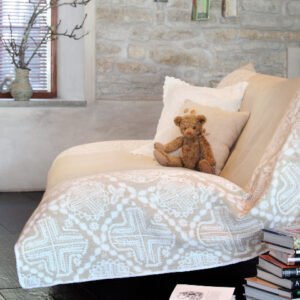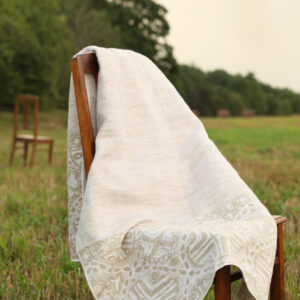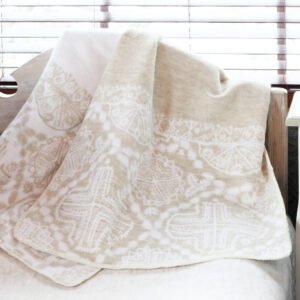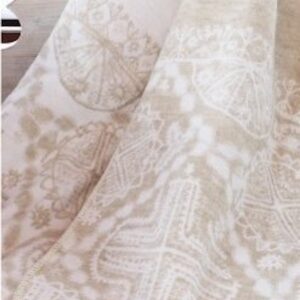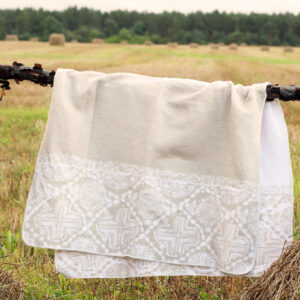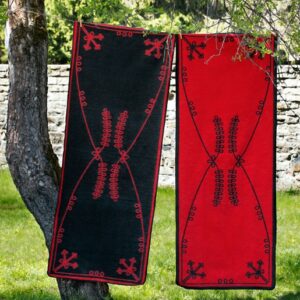+ Näita rohkem
-
Dimensions 66 x 180 cm 70% cotton, 30% flax In South Estonia, festive woollen rectangle wrap, worn across one’s shoulders, was the most respectable garment. In Põltsamaa, even on the 19th century oblong woollen shawls were worn. White shawl was decorated by using archaic techniques and patterns that had a deep meaning. South Estonian scarf is inspired by the shoulder piece of the Põltsamaa shirt where the pattern has been built up to form an ornament of diagonal cross and a quadrangle. That, in fact, is one of the oldest principles of composition. One of the characteristics of South Estonian handicraft is geometrical embroidery common in the late 18th century. White linen yarn was often used for that. Wrap had a specific role in the Jõgeva County wedding customs. When the bride was brought into the home of the bridegroom, her mother-in-law tied the wrap around the bride's head, covering the eyes as well.
-
Dimensions 70 x 200 cm 100% cotton
-
-
Dimensions 80 x 180 cm 70% cotton, 30% flax In South Estonia, festive woollen rectangle wrap, worn across one’s shoulders, was the most respectable garment. In Paistu, even on the 19th century oblong woollen shawls were worn. White shawl was decorated by using archaic techniques and patterns that had a deep meaning. South Estonian scarf is inspired by Paistu apron, where cross (symbol of balance; possesses a protective meaning), circle (symbol of infinity, perfection and harmony) and thuja (symbol of conception and fertility) can be seen. Such shawls were only worn by adult women.
-
Dimensions 60 x 180 cm 70% cotton, 30% flax In South Estonia, festive woollen rectangle wrap, worn across one’s shoulders, was the most respectable garment. In Paistu, even on the 19th century oblong woollen shawls were worn. White shawl was decorated by using archaic techniques and patterns that had a deep meaning. South Estonian scarf is inspired by Paistu apron, where cross (symbol of balance; possesses a protective meaning), circle (symbol of infinity, perfection and harmony) and thuja (symbol of conception and fertility) can be seen. Such shawls were only worn by adult women.
-
Dimensions 145 x 200 cm 70% cotton, 30% flax In South Estonia, festive woollen rectangle wrap, worn across one’s shoulders, was the most respectable garment. In Paistu, even on the 19th century oblong woollen shawls were worn. White shawl was decorated by using archaic techniques and patterns that had a deep meaning. South Estonian scarf is inspired by Paistu apron, where cross (symbol of balance; possesses a protective meaning), circle (symbol of infinity, perfection and harmony) and thuja (symbol of conception and fertility) can be seen. Such shawls were only worn by adult women.
-
Dimensions 80 x 180 cm 70% cotton, 30% flax In South Estonia, festive woollen rectangle wrap, worn across one’s shoulders, was the most respectable garment. In Paistu, even on the 19th century oblong woollen shawls were worn. White shawl was decorated by using archaic techniques and patterns that had a deep meaning. South Estonian scarf is inspired by Paistu apron, where cross (symbol of balance; possesses a protective meaning), circle (symbol of infinity, perfection and harmony) and thuja (symbol of conception and fertility) can be seen. Such shawls were only worn by adult women.
-
Dimensions 60 x 180 cm 70% cotton, 30% flax In South Estonia, festive woollen rectangle wrap, worn across one’s shoulders, was the most respectable garment. In Paistu, even on the 19th century oblong woollen shawls were worn. White shawl was decorated by using archaic techniques and patterns that had a deep meaning. South Estonian scarf is inspired by Paistu apron, where cross (symbol of balance; possesses a protective meaning), circle (symbol of infinity, perfection and harmony) and thuja (symbol of conception and fertility) can be seen. Such shawls were only worn by adult women.
-
Dimensions 35x 180 cm 70% cotton, 30% flax In South Estonia, festive woollen rectangle wrap, worn across one’s shoulders, was the most respectable garment. In Paistu, even on the 19th century oblong woollen shawls were worn. White shawl was decorated by using archaic techniques and patterns that had a deep meaning. South Estonian scarf is inspired by Paistu apron, where cross (symbol of balance; possesses a protective meaning), circle (symbol of infinity, perfection and harmony) and thuja (symbol of conception and fertility) can be seen. Such shawls were only worn by adult women.
-
Dimensions 105 x 180 cm 70% cotton, 30% flax In South Estonia, festive woollen rectangle wrap, worn across one’s shoulders, was the most respectable garment. In Paistu, even on the 19th century oblong woollen shawls were worn. White shawl was decorated by using archaic techniques and patterns that had a deep meaning. South Estonian scarf is inspired by Paistu apron, where cross (symbol of balance; possesses a protective meaning), circle (symbol of infinity, perfection and harmony) and thuja (symbol of conception and fertility) can be seen. Such shawls were only worn by adult women.
-
Dimensions 110 x 180 cm 70% cotton, 30% flax In South Estonia, festive woollen rectangle wrap, worn across one’s shoulders, was the most respectable garment. In Paistu, even on the 19th century oblong woollen shawls were worn. White shawl was decorated by using archaic techniques and patterns that had a deep meaning. South Estonian scarf is inspired by Paistu apron, where cross (symbol of balance; possesses a protective meaning), circle (symbol of infinity, perfection and harmony) and thuja (symbol of conception and fertility) can be seen. Such shawls were only worn by adult women.
-
Dimensions 70 x 180 cm 100% cotton The creation of Mulgi scarf is inspired by the design of long coat from Mulgi region. Some older folks probably still remember coats made of such a strong fabric that it could be easily put upright and it would stand on its own. A coat was to last a whole lifetime of the owner, because not many could buy a new piece of clothing every year. Therefore a lot of work and effort was needed to create a woolen fabric so strong and thick that it would last such a long time. A piece of home-made woolen fabric was pre-shrunk to last longer. Soap and alkali (ash mixed with water) and sometimes a bit of brine for meat were used. After rinsing the pre-shrunk fabric with the substances needed, and bread was taken out of the oven, the fabric was left to dry for a few hours on thatch on top of the oven. Nowadays a coat similar to that is made from a much softer fabric. It was then colored to make a coat as black as the bark of alder. To be historically correct, the woolen long coat (Mulgi coat) was worn as a piece of clothing that was supposed to keep one warm and, if needed, to keep a fur coat on its place. It was considered to be a piece of festive clothing and one of the most important articles of one’s wardrobe. Fur coats were usually made of white sheepskin and our winters where sometimes muddy even during the old times. So the black coat was supposed to protect the rest of the clothing from splatters of dirt flying from underneath the sleigh shoes. Until the mid-19th century the outer garments for both women and men had the same cut. In the late 19th century shoulder seam was added. Women fastened their coat skirts with hooks placed under their breast; men did so by using a belt. Dark Mulgi coats are decorated with braids that even nowadays are handmade. While wearing something red around one’s neck or shoulders or on one’s coat, the red-colored yarn and braids were believed to possess protective powers. One will need 11 meters of braid for women’s clothing. Moreover, when making a statelier coat from Karksi, Tarvastu or Helme regions, one will need an impressive 30 meters. Of course it depends on how many loops one wants to use to create a beautiful pattern. These decorations would demonstrate the wealth of the owner. But this notion didn’t start before the second half of the 18th century when red decorative loops started appearing on southern coats. In some places they said that you could demonstrate your wealth this way – the richer the owner (wearer) the more braids on the coat. The motifs would be used repeatedly but some details as arches, lines and borders would differ. The pattern created almost a circle around the coat. Protective circles were believed to keep the wearer from bad words (or curses) and angry looks.







